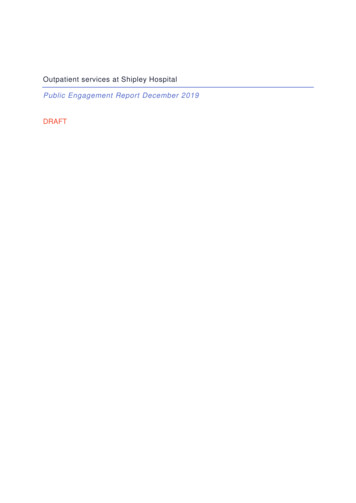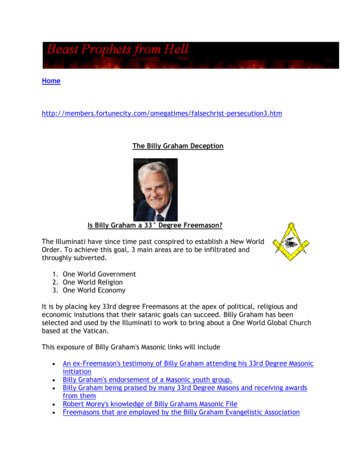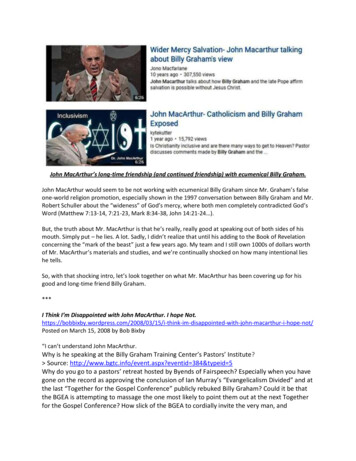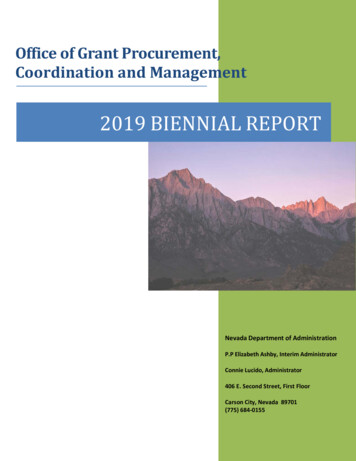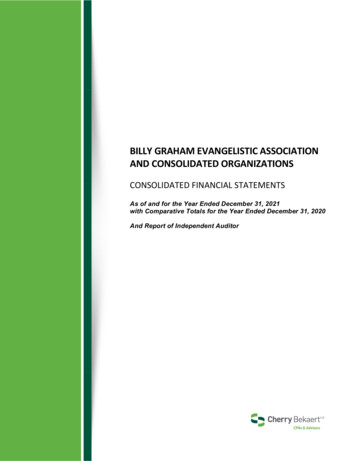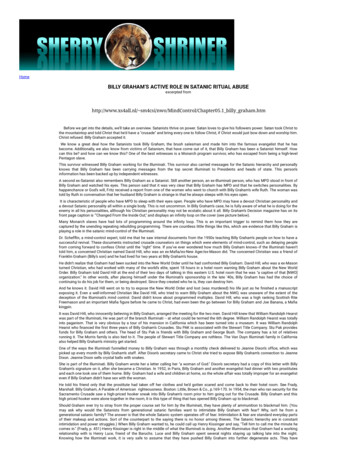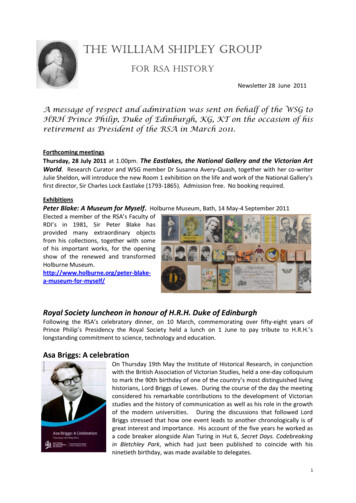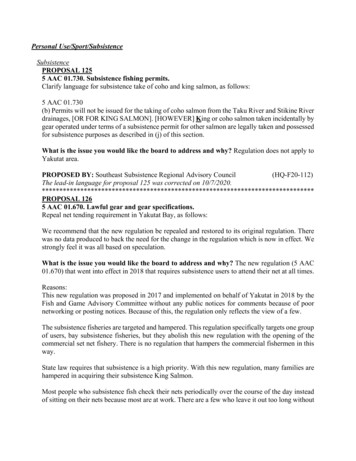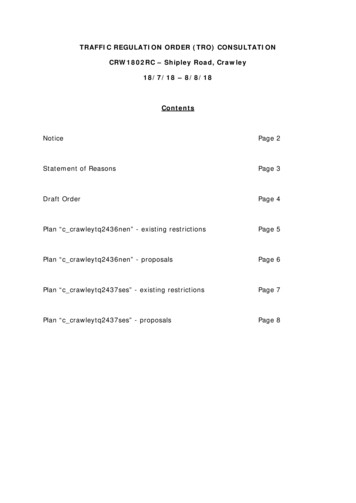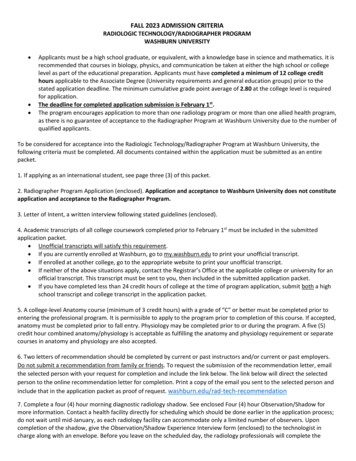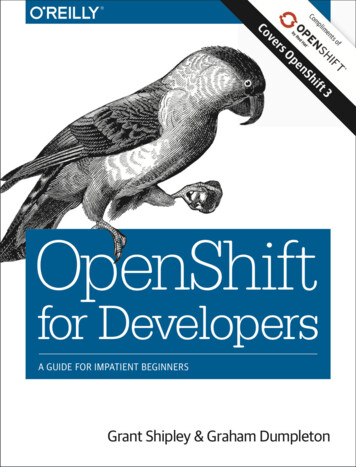
Transcription
OpenShift for DevelopersA Guide for Impatient BeginnersGrant Shipley and Graham DumpletonBeijingBoston Farnham SebastopolTokyo
OpenShift for Developersby Grant Shipley and Graham DumpletonCopyright 2016 Red Hat, Inc. All rights reserved.Printed in the United States of America.Published by O’Reilly Media, Inc., 1005 Gravenstein Highway North, Sebastopol, CA 95472.O’Reilly books may be purchased for educational, business, or sales promotional use. Online editions arealso available for most titles (http://safaribooksonline.com). For more information, contact our corporate/institutional sales department: 800-998-9938 or corporate@oreilly.com.Editors: Brian MacDonald and Heather SchererProduction Editor: Melanie YarbroughCopyeditor: Christina EdwardsInterior Designer: David FutatoCover Designer: Randy ComerIllustrator: Rebecca DemarestFirst EditionJune 2016:Revision History for the First Edition2016-05-18:First ReleaseThe O’Reilly logo is a registered trademark of O’Reilly Media, Inc. OpenShift for Developers, the coverimage, and related trade dress are trademarks of O’Reilly Media, Inc.While the publisher and the authors have used good faith efforts to ensure that the information andinstructions contained in this work are accurate, the publisher and the authors disclaim all responsibilityfor errors or omissions, including without limitation responsibility for damages resulting from the use ofor reliance on this work. Use of the information and instructions contained in this work is at your ownrisk. If any code samples or other technology this work contains or describes is subject to open sourcelicenses or the intellectual property rights of others, it is your responsibility to ensure that your usethereof complies with such licenses and/or rights.978-1-491-94300-7[LSI]
Table of ContentsForeword. . . . . . . . . . . . . . . . . . . . . . . . . . . . . . . . . . . . . . . . . . . . . . . . . . . . . . . . . . . . . . . . . . . . . viiIntroduction. . . . . . . . . . . . . . . . . . . . . . . . . . . . . . . . . . . . . . . . . . . . . . . . . . . . . . . . . . . . . . . . . . . ix1. Introduction to a Container Application Platform. . . . . . . . . . . . . . . . . . . . . . . . . . . . . . . . 1DockerKubernetes to the Rescue?OpenShiftWeb-Based ConsoleCommand-Line ToolSource-to-ImageIntegrated Logging and MetricsSummary233455562. Concepts You Need to Understand. . . . . . . . . . . . . . . . . . . . . . . . . . . . . . . . . . . . . . . . . . . . . 7Interacting with OpenShiftThe Deployed ApplicationBuild and Deployment ProcessOnline Cheat SheetSummary791011113. Installing the All-in-One VM. . . . . . . . . . . . . . . . . . . . . . . . . . . . . . . . . . . . . . . . . . . . . . . . . . 13Software RequirementsInstall VirtualBoxInstall VagrantVagrant initChange Your Memory ConfigurationStart Things Up141414151515iii
Download the Latest oc Command-Line ToolInitial Login from the Web ConsoleNow Log In from the Command LineNow Log In to the Web Console as a Normal UserCreate a GitHub AccountSummary1516181819204. Developing and Deploying Your First Application. . . . . . . . . . . . . . . . . . . . . . . . . . . . . . . . 21Understanding the ToolsGitWildFlyCreating Our First ApplicationCreating a Copy of the Sample ApplicationCreating the ApplicationMaking a Code Change and Starting a New BuildSummary21212223232427285. Adding Dependencies and a Database. . . . . . . . . . . . . . . . . . . . . . . . . . . . . . . . . . . . . . . . . 29Creating the Base ApplicationForking the Repository and Deploying the ApplicationAdding the Database to the ApplicationAdding a REST EndpointSummary29293839416. Deploying and Scaling Your Application. . . . . . . . . . . . . . . . . . . . . . . . . . . . . . . . . . . . . . . . 43Automatic Deployments Using WebhooksAdding Our Webhook URI to GitHubVisibility of Your OpenShift InstanceScaling Your ApplicationScaling from the Web ConsoleApplications Suitable for ScalingAutomatic Scaling of an ApplicationDeployment StrategiesRolling StrategyRecreate StrategyChanging the StrategyImplementing Custom StrategiesApplication Health ChecksDeployment Lifecycle HooksApplication RollbackSummaryiv Table of Contents43434646474848484849495050525455
7. Using Application Templates. . . . . . . . . . . . . . . . . . . . . . . . . . . . . . . . . . . . . . . . . . . . . . . . . 57What Is an Application Template?Benefits of Using TemplatesUsing Our First Application TemplateCreating Your Own TemplatesSummary57585860618. Working with Your Application. . . . . . . . . . . . . . . . . . . . . . . . . . . . . . . . . . . . . . . . . . . . . . . 63Listing Running InstancesContainer LogsBuild LogsApplication LogsApplication Startup FailuresEnvironment VariablesEditing ConfigurationsDebugging an ApplicationDeleting an ApplicationSummary636464656566676870719. Deploying an Existing Docker Image. . . . . . . . . . . . . . . . . . . . . . . . . . . . . . . . . . . . . . . . . . 73What Is Docker Hub?The DockerfileThe Docker BuildSharing the Docker ImageRunning a Docker Hub Image on OpenShiftRoutesSummary73737575757679Afterword. . . . . . . . . . . . . . . . . . . . . . . . . . . . . . . . . . . . . . . . . . . . . . . . . . . . . . . . . . . . . . . . . . . . 81Table of Contents v
ForewordOur industry is changing. It no longer matters what type of company you work for. Itno longer matters what industry you are in. Software is becoming the tool on whichthe futures of our companies are built, both small and large.At the center of this change is the evolution of software development itself. Opensource development models have taken over. Agile practices are needed as the pace atwhich one needs to respond to competition or changes in the market is relentless.Linux containers have exploded onto the market as the new basis on which to buildconnections between development and operations. And harnessing infrastructure foryour application, from public cloud to private infrastructure, is a necessity.For some, it can feel like the pace of change is so fast that it’s better to not change atall. Having been lucky enough to participate in many of the aforementioned changes,I can assure you this is not a good position. Those who find the way to harness thesechanges are disrupting entire industries. It will soon be a necessity, not an option tochart your course.When we set out to build OpenShift, this was our goal. We wanted a way for softwaredevelopers to take their new idea and make it a reality. We wanted to bring them thelatest technology to use to their advantage in a simple way so their energy could befocused on their idea. To be this guide for developers, we have also had to constantlyevolve in support of this mission.Grant Shipley has been at the center of our evolution. He has been our link to thedevelopers and our guide in keeping our focus on our end users. His passion for opensource and his passion for development come through in everything he does. I’vewatched as Grant has grown from a innovative software developer to an amazingspeaker and champion of our product and mission. He’s done an inspiring job of cap‐turing that spirit in this book and I truly thank him for continuing to drive us in ourmission.vii
Graham Dumpleton has come to us from the Python developer community where hehas been a key contributor in the area of Python web application deployment. He wasthe author of the Apache module called mod wsgi, a popular choice among Pythondevelopers for deploying their web applications. Graham is using all that experienceto help drive forward improvements in our support for Python in OpenShift as wellas our build systems based around Source-to-Image (S2I).They both bring a wealth of experience to this book and I hope it helps propel you tothat next great idea.— Matt HicksVP, Engineering at Red Hatviii Foreword
IntroductionOpenShift has been available since 2011 and has seen great success as a polyglot plat‐form for the deployment of web applications and services. Part of the success ofOpenShift derives from the use of containers in conjunction with a SecurityEnhanced Linux (SELinux) environment. These technologies enable OpenShift toimplement a secure multi tenant environment suitable for the enterprise, as well asOpenShift Online, Red Hat’s own public platform as a service (PaaS) offering.Technology is always evolving, and to keep up with the latest advances OpenShift hasalso evolved. The latest version of OpenShift takes advantage of newer technologiessuch as Docker and Kubernetes, for managing and running applications within con‐tainers. Building on Kubernetes and OpenShift’s own magic sauce, OpenShift takesPaaS to a new level, what we like to call a container application platform.OpenShift offers you the ability to easily deploy your web application code directlyusing a library of pre-defined image builders, or you can bring your own Dockerimages. With support in OpenShift for features such as persistent volumes, you arenot limited to just running 12-factor or cloud native applications. You can also deploydatabases and many legacy applications which you otherwise would not be able torun on a traditional PaaS.OpenShift is the modern take on PaaS that you can use with your current applica‐tions, but which also provides the power and flexibility to meet future needs. Thisbook will bring you up to speed on how OpenShift has changed to meet the newrequirements for building, deploying and hosting your applications.Who Should Read This BookIf you are impatient, this book is for you. It is intended for programmers who want toget started using OpenShift as quickly as possible, but also want to understand a littlebit of what they are doing.ix
We will step you through how to build and deploy your first application, and alsointroduce you to the main concepts of OpenShift and the tools available for workingwith OpenShift.As the title indicates, we are assuming little in the way of background knowledgeexcept: You have some basic programming experience. You know how to create a web application. You know how to use the command line. You can use a text editor on a console.We also assume you are familar with basic Linux or Windows shell commands, andhow to install additional software to your computer.The software you install will provide you with a complete working OpenShift envi‐ronment that you can use locally for development or testing.We have used Java and the WildFly application server for the examples in this book.You do not need to be proficient in Java. If you are familar with any of the popularprogramming languages you will do just fine.Why We Wrote This BookWe want to enable you to become self-sufficient in the basic use of OpenShift for cre‐ating and hosting your web applications, in as few words as possible. Therefore, wewill not go into long explanations of the technologies used in OpenShift or differentprogramming paradigms, but instead will give you links where you can go to readmore.Navigating This BookThe aim of this book is to get you up and running on OpenShift as quickly as possi‐ble. To that end, we dive into the most crucial content first and fill in the finer detailsas we go along. Chapters 1 and 2 provide a basic introduction to a container application plat‐form, as well as the basic terms and technologies you will need to understand forthe rest of the book. Chapter 3 provides instructions on how you can install a self contained versionof the OpenShift environment on your own computer. Chapter 4 steps you through deploying your first application to OpenShift.x Introduction
Chapter 5 adds in a database to the application, providing it with a way of man‐aging application data. Chapter 6 delves into managing deployments of your application and how toscale it up to handle more users. Chapter 7 introduces application templates, a means of simplifying new applica‐tion deployments. Chapter 8 covers basic management commands for working with and under‐standing what your application is doing. Chapter 9 discusses deploying your own Docker images to OpenShift.Online ResourcesIn this book you will install a self contained OpenShift environment based on Open‐Shift Origin. This is the upstream Open Source version of OpenShift that Red Hat’sOpenShift Enterprise, OpenShift Dedicated and OpenShift Online products are basedon. The all-in-one virtual machine used is available from the OpenShift Origin site.OpenShift Origin will always include all the latest features, with support being pro‐vided by the OpenShift community.The OpenShift product releases are created as a regular snapshot of the OpenShiftOrigin project. The product releases do not always have the very latest features, but ifyou have a commercial Red Hat subscription, the product releases include supportfrom Red Hat.If you would like to try out the OpenShift Enterprise version, a couple of options areavailable.The first is to sign up to the Red Hat developers program at Red Hat Developers page.This is a free program and allows you to access versions of Red Hat products for per‐sonal use on your own computer. One of the products made available through theprogram is the Red Hat Container Development Kit.This includes a version of OpenShift that you can install on your own computer, butwhich is based on OpenShift Enterprise rather than OpenShift Origin.A second way of trying out OpenShift Enterprise is via the Amazon Web Services(AWS) Test Drive program.This will set you up an OpenShift environment running across a multi node clusteron AWS.Take a look at more in-depth documentation on OpenShift and how to use it at theOpenShift documentation site.Introduction xi
Check out the OpenShift blog, where regular articles are published on OpenShift.Want to hear about how others in the OpenShift community are using OpenShift, orwish to share your own experiences, you can join the OpenShift Commons.If you have questions or issues, you can reach the OpenShift team through StackOverflow, via email to openshift@redhat.com, on Twitter (@openshift), or in the#openshift channel on IRC’s FreeNode network.Conventions Used in This BookThe following typographical conventions are used in this book:ItalicIndicates new terms, URLs, email addresses, filenames, and file extensions.Constant widthUsed for program listings, as well as within paragraphs to refer to program ele‐ments such as variable or function names, databases, data types, environmentvariables, statements, and keywords.Constant width boldShows commands or other text that should be typed literally by the user.Constant width italicShows text that should be replaced with user-supplied values or by values deter‐mined by context.This icon signifies a tip, suggestion, or general note.This icon indicates a warning or caution.Using Code ExamplesSupplemental material (code examples, exercises, etc.) is available for download athttps://github.com/gshipley/book-insultapp.This book is here to help you get your job done. In general, if example code is offeredwith this book, you may use it in your programs and documentation. You do notxii Introduction
need to contact us for permission unless you’re reproducing a significant portion ofthe code. For example, writing a program that uses several chunks of code from thisbook does not require permission. Selling or distributing a CD-ROM of examplesfrom O’Reilly books does require permission. Answering a question by citing thisbook and quoting example code does not require permission. Incorporating a signifi‐cant amount of example code from this book into your product’s documentation doesrequire permission.We appreciate, but do not require, attribution. An attribution usually includes thetitle, author, publisher, and ISBN. For example: “OpenShift for Developers by GrantShipley and Graham Dumpleton (O’Reilly). Copyright 2016 Rad Hat, Inc.,978-1-491-94300-7.”If you feel your use of code examples falls outside fair use or the permission givenabove, feel free to contact us at permissions@oreilly.com.Safari Books OnlineSafari Books Online is an on-demand digital library that deliv‐ers expert content in both book and video form from theworld’s leading authors in technology and business.Technology professionals, software developers, web designers, and business and crea‐tive professionals use Safari Books Online as their primary resource for research,problem solving, learning, and certification training.Safari Books Online offers a range of product mixes and pricing programs for organi‐zations, government agencies, and individuals. Subscribers have access to thousandsof books, training videos, and prepublication manuscripts in one fully searchabledatabase from publishers like O’Reilly Media, Prentice Hall Professional, AddisonWesley Professional, Microsoft Press, Sams, Que, Peachpit Press, Focal Press, CiscoPress, John Wiley & Sons, Syngress, Morgan Kaufmann, IBM Redbooks, Packt,Adobe Press, FT Press, Apress, Manning, New Riders, McGraw-Hill, Jones & Bartlett,Course Technology, and dozens more. For more information about Safari BooksOnline, please visit us online.Introduction xiii
How to Contact UsPlease address comments and questions concerning this book to the publisher:O’Reilly Media, Inc.1005 Gravenstein Highway NorthSebastopol, CA 95472800-998-9938 (in the United States or Canada)707-829-0515 (international or local)707-829-0104 (fax)To comment or ask technical questions about this book, send email to bookques‐tions@oreilly.com.For more information about our books, courses, conferences, and news, see our web‐site at http://www.oreilly.com.Find us on Facebook: http://facebook.com/oreillyFollow us on Twitter: http://twitter.com/oreillymediaWatch us on YouTube: GrantWriting a book of any length takes a considerable amount of time. This is time that ismost often stolen from my family. For that reason, I would like to thank my wonder‐ful wife Leah and our four children—Jackson, Emily, Gavin, and Mason. Withouttheir support and understanding, I would not have been able to create this book. Ilove you all very much.I would also like to thank the entire OpenShift team at Red Hat, but especially theindividuals who work directly on my team: Diane, Graham, Steve, Ryan, Jorge, andMarek. Working with such a fine group of folks makes this job not seem like a job atall and more about fun and pushing new technologies to the limit.Other people I would like to thank, in no particular order, are as follows: Ashesh,Matt, Joe, Mike, Jake, Shawn, Sathish, Sam, Corey, Clayton, Dan, Thomas, Keck, Burr,Jakub, Miciah, and everyone else who has made OpenShift such a success. Lastly, Iwould like to thank Alexa Overbay for her dedication to the project and all of thehard work she puts in to help myself and the OpenShift team stay organized and run‐ning smoothly.xiv Introduction
GrahamI would like to thank Grant and Red Hat for giving me the opportunity to work at acompany which values and contributes to Open Source projects. I am a strongbeliever in Open Source and the good that it can create in the wider community.Through my own projects I have been attempting to improve the options available toPython developers for hosting web applications. I see the OpenShift project as being avery important part of that story and am thankful for the opportunity to work on it.With a family, my wife Wendy and two young children Kara and Caiden, the flexibil‐ity of being able to work remotely from home in my role with Red Hat has helpedimmensely in managing the day to day demands of children working their waythrough school. It does mean I often work strange hours and occasionally need totravel, but I have a family which is more than tolerant and is supportive of me, forwhich I am very grateful.Introduction xv
CHAPTER 1Introduction to a ContainerApplication PlatformIn the few years since the original version of OpenShift was released, the cloud eco‐system has expanded at a rapid pace. New technologies and systems are springing upalmost overnight. The new version of OpenShift (version 3) includes other technolo‐gies at the core of the platform, and it’s worth it to spend some time learning aboutthem and how to incorporate them into your development work. The core technol‐ogy used as the basis of OpenShift includes Docker-based containers and orchestra‐tion via the Kubernetes system. Given that the core of the platform is based oncontainers, we often refer to OpenShift as a container application platform in that it isa platform designed for the development and deployment of containers.1
So why did the OpenShift team rewrite their perfectly good PaaS(OpenShift 2)? The core architecture of OpenShift was built a bitover 4 years ago, which in the cloud evolution years (like dog years)is about 28 years ago, and a lot has changed since then. One exam‐ple is Docker, which we discuss later in this chapter. The begin‐nings of the Docker project that you know today started as acontainer implementation using cgroups and kernel namespaces ata PaaS company named dotCloud. In March of 2013, the Dockerproject was released as an open source project and in July 2013, thecompany behind dotCloud pivoted and announced that their pri‐mary focus going forward would be the Docker container technol‐ogy. OpenShift has been using containers since the beginning butthe OpenShift team saw great potential within the Docker ecosys‐tem—i.e., its potential as a “standard” for packaging applications,thereby creating better portability across environments.The landscape in the cloud area has also been changing rapidly.The OpenShift team has four years of experience running one ofthe largest public PaaS systems and a large and successful installbase of the on-premise enterprise version. The OpenShift teamrealized the time was right to use our knowledge, industryadvancements, and new FOSS cloud projects to create an even bet‐ter platform, which has been released as the OpenShift 3 containerapplication platform.DockerUnless you have been living under a rock last two years, you have certainly heardabout Docker and probably even heard about how Docker-based containers can solveall of your problems. While it is true that Docker-based containers are certainly cool,we need to be realistic about what this great technology provides and what it doesn’t.In its simplest form, Docker provides users with a lightweight portable format thatcan be used to ship images of an application around to different environments. Itaccomplishes this while also packaging up all of the dependencies at both the systemand application level to ensure the application runs as expected when deployed.While Docker provides a great portable container format to ship applications around,it is important to remember that using Docker-based containers is just a small piecein the overall deployment puzzle that many organizations and individual developersface. A single Docker container that contains your application code is pretty trivial toget started with but once you move past the single container phase for your applica‐tion, things become complex quickly, often leaving the developer to understandoperational tasks instead of focusing on code. You may be thinking, “What on earth ishe talking about?” For starters, things like:2 Chapter 1: Introduction to a Container Application Platform
Load balancing a set of containers with or without session affinity Mounting persistent storage inside of the containers Placement and scheduling of containers on the infrastructure Rolling deployments and other operational considerations that traditional devel‐opers are not experts onAs you can see, things get complicated quickly when moving from a single develop‐ment container to a real production application.Given that Docker-based containers are such an important piece of the puzzle in acontainer application platform, Red Hat and the OpenShift team have spent a tre‐mendous amount of engineering effort working on and with the Docker upstreamproject. In fact, at the time of writing, Red Hat is the second largest contributor to theproject.Kubernetes to the Rescue?While Docker gets us a portable lightweight runtime, it lacks features for supportingn-tier applications. The OpenShift team understood this early on in the researchphase when planning the new platform. We searched high and low for a great orches‐tration and scheduling system and made an early bet on the Kubernetes project Goo‐gle started, and are now seeing great benefits as a result of that decision. Let’s talk alittle bit more about the Kubernetes project as you may not be familiar with it.Kubernetes is a free and open source project started by Google in 2014. The first ver‐sion was released in July 2015. The project is based off the Borg project, the technol‐ogy Google uses to run containers at scale internally, launching over 7000 containersper second. When it came time to build their next version of the software they deci‐ded to open source the effort and Kubernetes was born.Red Hat and the OpenShift team were key contributors to Kubernetes because of thevalue we see in the project to help with the scheduling, orchestration, and running ofDocker-based containers for production workloads.Again, just to be clear, both Docker and Kubernetes are great. However, they are justtwo pieces of the container application platform puzzle.OpenShiftAfter all this goodness with Docker and Kubernetes, you are probably wonderingwhere OpenShift fits in to the overall puzzle and what piece the platform provides. Itturns out that Kubernetes is excellent at orchestrating and scheduling containers, butto have a platform that helps developers and sys admins deal with the piece mostKubernetes to the Rescue? 3
important to their “customers”—the application—something more is needed. Thegoal of OpenShift is to provide the best experience for developers and sysadminsdeveloping, deploying, and running applications. In other words, OpenShift is a layeron top of Docker and Kubernetes that makes it accessible and easy for the developerto create applications and a platform that is a dream for operators to deploy contain‐ers on for both development and production workloads.We are going to quickly cover some of the features OpenShift brings to the table tohelp developers (since that is the focus of this book) and then we will explore thesemore in depth throughout the book.Web-Based ConsoleThe OpenShift platform ships with a feature-rich web console that allows developersto perform the actions needed to deploy and run existing source code projects. Forexample, one of the features (as shown in Figure 1-1), is a graphical representation ofan application that consists of multiple containers all load balanced, while also using adatabase as the backend storage engine.Figure 1-1. OpenShift resource visualizationOther tasks a developer would normally perform via the web console is scaling theapplication containers, creating projects, viewing log files, viewing the memory andCPU utilization of a container, and other common functions. The web console is agreat tool as it provides a single interface for all aspects of your development project.4 Chapter 1: Introduction to a Container Application Platform
Command-Line ToolOpenShift also provides a command-line tool that is written in the Go programminglanguage. This tool, called oc, is a single binary executable provided for all majoroperating systems including Microsoft Windows, Apple OS X, and Linux. If youenjoy working on the command line, the oc tool is a first-class citizen and can be usedto perform any operation that can be accomplished via the web console. The greatestbenefit of using the oc command-line tool is that you have a single executable to per‐form all operations instead of having to interface directly with multiple tools such asthe ones provides with Docker and Kubernetes. You can think of it as “one tool torule them all.” Okay, that may be a bad LOTR reference, I know.Source-to-ImageThe true power of OpenShift comes in with the S2I (Source-to-Image) open sourceproject that the OpenShift Team created as part of the OpenShift platform. The teamknows that developers want to take advantage of all of the benefits that running appli‐cations in containers provides, but don’t want to spend their day creating Dockerfilesor running Docker builds while also having to do all of the orchestration by hand.In its simplest form, the S2I-based Docker images allow developers to interact withthe platform from a pure source code perspective. What this means is that OpenShiftonly needs to know the URL of your git repository and then the platform takes careof the rest. Under the covers, when you create a new project and container, the plat‐form matches a base image of the desired runtime up with your source, performs abuild, and then creates a new Docker image on the fly.For a more concrete example, let’s assume we have a Java-based project that uses theMaven build system. When using the WildFly application server and a git repositorythat contains your code, the platform will download the base WildFly image, cloneyour repo, identify it as a Maven project, run a Maven build, and take the artifact ofthat build and create a new Docker image that contains both the WildFly runtime andyour build artifact. Finally, it will deploy the build artifact and then start up theresulting container. I know this may sound complicated, but don’t worry, the platformtakes care of all of the heavy lifting. We will dive into more detail as we progressthrough the book.Integrated Logging and MetricsOne of the most important aspects of any software development project is the abilityto troubleshoot issues as they arise. Since the beginning of time, one of the first placesa developer looks when beginning the debug process is the application logs for theproject. OpenSh
Chapter 9 discusses deploying your own Docker images to OpenShift. Online Resources In this book you will install a self contained OpenShift environment based on Open‐ Shift Origin. This is the upstream Open Source version of OpenShift that Red Hat's OpenShift Enterprise, OpenShift Dedicated and OpenShift Online products are based on.
